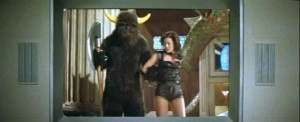
WHEN George Lucas’s space fantasy Star Wars premiered in the summer of 1977 – and promptly became the highest grossing film in history – it was only a matter of time before intrepid filmmakers sought to imitate and thus re-capture the movie’s magic in a slew of lookalike films.
Importantly, the Star Wars film craze not only brought a barrage of new science fiction-themed films to the international box office, it also changed the very way that movie-makers approached the difficult-to-visualize genre.
Before Star Wars, the 1970s SF cinema obsessed, largely, on matters of environmental disaster and future dystopias like Soylent Green (1973) and Logan’s Run (1976).
After Star Wars, however, science fiction films usually featured more action, colorful laser blasts, cute robotic sidekicks, and a concentration on fantasy aspects.
Some of titles from the 1970s-1980s Star Wars craze include Message from Space (1977), Starship Invasions (1977), Star Crash (1978), The Humanoid (1979), The Shape of Things to Come (1979), Galaxina (1980), and Space Raiders (1983).
Below is a list of five of the best examples of the trend.
You will note that the films that make this list are, generally, ones that develop their narratives from literature, myth or film beyond the obvious Star Wars riffs; inspiration such as Jules Verne’s 20,000 Leagues Under the Sea, Akira Kurosawa’s Seven Samurai (1954), Arthurian legend, or even Chariots of the Gods.
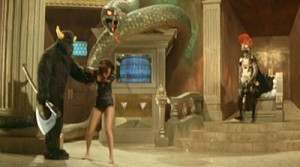
The War in Space (1977)
This Japanese effort is not as well-known as another Star Wars knock-off from the same year, Message from Space (1977), but it’s a superior film. If Star Wars qualifies as a smart pastiche of Flash Gordon, Buck Rogers and other early pulp space adventures of the West then The War in Space seems determined to mine Japanese film history instead.
The film involves an attack on Earth by alien invaders. Our world has no sufficient defense against such an initiative, save for a top-secret warship called Gohten built by Professor Takigawa (Ryo Ikebe), a man reluctant to see the ship’s fearsome power utilized. With no recourse but to fight, however, Takigawa commands the Gohten in battle against the Evil Space Emperor, now headquartered on Venus.
Although it remains a baffling touch that the alien attack ship in the film resembles a Roman sea vessel from Antiquity, The War in Space is sharp and entertaining in other ways. It cannily pays tribute to a number of films and concepts from Japanese film history. The Gohten, for instance, is a re-dress of the central vessel in Atragon (1963), although there it was a submarine.
Similarly, Takigawa’s subplot, involving his reluctant use of a dreadful weapon, recalls Dr. Serizawa and the Oxygen Destroyer in Godzilla (1954). Both men of peace die while deploying the dangerous ship/weapon, so that future generations cannot exploit its horrors.
The War in Space even recalls Space Cruiser Yamato (1977) to some degree in its tale of a brave Earth crew going to space to battle an implacable foe.
The Star Wars-inspired touches are also many, and sometimes downright weird. The Space Emperor’s right-hand minion is a giant Wookie-like creature with bull horns who wields not a light sword, but a light-hatchet. Oddly, when he captures the film’s heroine, the hairy beast makes the imperiled woman dress in leather fetish gear, anticipating, perhaps, Princess Leia’s slavery to Jabba the Hutt in Return of the Jedi(1983).
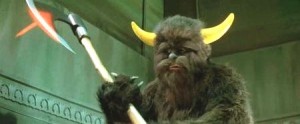
Also watch for the scene where the Gohten crew mentions in passing an “R2” antenna.”
R-who?
Finally, the film’s central battle scene involves the heroes flying tiny space fighters through a trench on Venus, a close corollary for the Death Star fight.
Commendably, however, The War in Space is a film with a well-developed conscience about its subject matter — war — and that fact makes it worth watching. As we see in the Godzilla movies as well, there’s a genuine fear here of the next Pandora’s Box, the next devastating technology that man might exploit to harm Mother Earth. In attempting to repel an invasion of aliens, The War in Space suggests, there is always the possibility that Earth people will become as dangerous and corrupt as their extra-planetary foes.
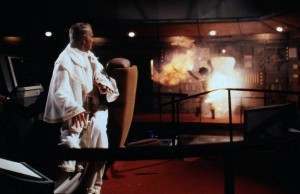
Battlestar Galactica (1978)
Ron Moore, the talent behind the 2000s re-imagination of Battlestar Galactica famously termed the original Glen Larson saga (made for TV but released theatrically…) “popcorn.” This derisive description suggests that the source material is a simple, gee-whiz, slam-bam space fantasy patterned after Star Wars.
A close re-watch of the theatrical film (or first episode…) reveals that this glib assessment may be erroneous, however. If Moore’s second run at the material seeks to be a left-wing allegory about America post-9/11, the original Galactica film is similarly political in nature, only from the opposite viewpoint.
To wit, Battlestar Galactica’s tale of “ancient astronauts” fleeing the Cylon tyranny clearly reflects the Von Daniken Chariots of the Gods aesthetic that proved so popular during the disco decade. But the film also features, surprisingly, a hard-right message about foreign affairs.
Specifically, Battlestar Galactica involves western suspicions about Détente, a Russian policy designed to ease the competition between ideological enemies via negotiations rather than military brinkmanship.
This Détente context is mirrored in the Galactica set-up: the Colonies of Man face the possibility of peace with a long-time enemy, the Cylons, but the Cylons are up to no good. A peaceful, easily-manipulated President Adar (Lew Ayres) thus provides a clear corollary for Jimmy Carter, the nation’s Commander-in-Chief at the time: good-intentioned yet perceived to be naïve or weak. Adar, we see, would willingly establish peace and suspend war footing rather than contend with the Cylon threat from a position of military strength. Many hawks in America worried about Carter doing the exact same thing, especially as he negotiated the SALT II (Strategic Arms Limitation Treaty) with the Soviets.
In 1978 — The American Security Council’s“Year of the Coalition of Peace through Strength” — Battlestar Galactica thus compared hardened, suspicious Cold Warrior Adama (Lorne Greene) with naïve Adar, and even Russia’s State Newspaper Izvestia detected the pointed social commentary:
“The galactical [sic] negotiations between the people and the Cylons really resemble the U.S.-Soviet peace talks…The crafty Cylons, similar to ‘crafty Soviets’ propose to the president of the galactical union something like space détente.”
Russan writer Melor Sturia also opined in the same piece that Battlestar Galactica was “Anti-Soviet symbolism dressed in a transparent tunic of science fiction.”
This paranoid Cold War allegory renders Battlestar Galactica quite a different animal than Star Wars, and a legitimate work of art in its own right. Still, the movie also speaks fluently in the language of Star Wars. Battlestar Galactica features the requisite cute robot sidekick — Muffit the Daggitt — and space dogfights created by Star Wars special effects director, John Dykstra.
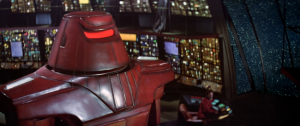
The Black Hole (1979)
Although this film — the first in Disney history to be rated PG — also speaks fluently in the language of Star Wars and thus includes adorable robot sidekicks (V.I.N.Cent, Old B.O.B.), Stormtrooper-like minions called Sentries, and lots of lasers flashing in all directions, The Black Hole is nonetheless a strong contrast to Lucas’s blockbuster because it features an absolutely dark heart. The movie was, and remains, downright creepy at points.
The Black Hole depicts the tale of a ghost ship called the Cygnus, and the crew of another starship, the Palomino that discovers te lost vessel hovering near a dangerous black hole. The crew of the Palomino, played by Robert Forster, Yvette Mimieux, Anthony Perkins, Joseph Bottoms and Ernest Borgnine, learns that the Cygnus’s mad commander, Reinhardt (Maximillian Schell) has lobotomized his human crew and transformed them into obedient zombies.
Worse, the ship is overseen by a bright red, devil robot called Maximillian, one that even Reinhardt himself fears. Reinhardt’s insane dream is to pilot the Cygnus through the black hole’s event horizon and learn what exists on the “other side.”
With the Cygnus substituting for the Nautilus and Reinhardt functioning as an outer space version of Captain Nemo, The Black Hole features strong resonances of Jules Verne’s 20,000 Leagues Under the Sea (1959).
But The Black Hole reaches an artistic zenith in its final moments as the Cygnus and Palomino crews enter the black hole. There, the characters countenance a kind of Manichean universe, a reality bifurcated by realms of darkness and light, body and soul.
Maximillian and Reinhardt end up in the realm of darkness – perhaps Hell – with the soulless humanoids.
Meanwhile, the Palomino survivors are guided to a realm not of fire and damnation, but of spirit. They travel down a long tunnel of light, and then emerge at the end of the tunnel to see a giant white sun…a beacon of hope in a new universe.
The inference here is that the pure of heart transcend the physical dimension, at least for a time, while Reinhardt — true evil personified — can look forward to no such release or apotheosis. Instead, he becomes trapped for all eternity inside the hard, unyielding shell of the evil Maximillian, the very creation he so dreaded.
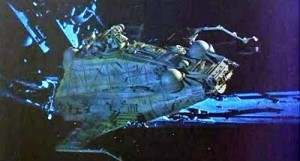
Battle Beyond the Stars (1980)
From cinematic classics, Seven Samurai (1954) and The Magnificent Seven (1960), the low-budget Roger Corman film Battle Beyond the Stars adopts it central premise. Specifically, a group of peace-loving locals must hire outside mercenaries to protect themselves from a conquering intruder.
In Kurosawa’s Seven Samurai and Sturges’ The Magnificent Seven, the imperiled folk are simple farmers and the inhabitants of a border town, and the invaders are marauders or bandits. Meanwhile, the mercenaries are ronin (samurai without masters) in Kurosawa’s effort, and in the western film they are gunslingers for hire.
All such earthbound character types have been transplanted to more “cosmic” ones for Battle Beyond the Stars. The Akir must not defend a mere village, but a planet itself.
And evil Sador (John Saxon) is not only a leader of roving bandits, but a warlord capable of destroying whole worlds if they don’t bend to his will.
Finally, the mercenaries are a motley crew of alien races, each with memorable and unique physical characteristics; each as colorful and dynamic as Chewbacca, Han Solo, Greedo or C-3P0,
In each of the three re-tellings of the same story, other commonalities are plain. In all instances, the visiting defenders are initially greeted with trepidation by the local inhabitants. Despite the fact that these soldiers of fortune have agreed to guard the imperiled locales, they are still viewed suspiciously, and as dangerous outsiders.
Soon, the attitudes change in some incarnations of the tale, and a romance even blossoms between a mercenary and a villager. In The Magnificent Seven, Vic (Steve McQueen) and Petra (Rosenda Monteros) become romantically involved,while in Battle Beyond the Stars, Cowboy (George Peppard) and Lux (Marta Kristen) engage in a similar relationship.
The call-backs to Seven Samurai and The Magnificent Seven alone distinguish Battle Beyond the Stars from its space craze competition in the late 1970s and early 1980s, but the film remains remarkable too for its good (if low-budget) special effects, and the way in which the production diagrams a distinct look or vibe for each planet and each alien group featured in the mercenary ranks.
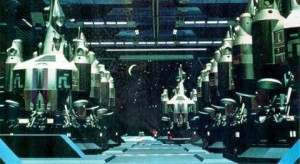
The Last Starfighter (1984)
In The Last Starfighter (1984), Alex Rogan (Lance Guest) lives at the backwater Starlite-Starbrite Trailer Pack with his mom and kid brother, hoping for some way to see the world, and leave his home behind.
When Alex achieves the new high score on the arcade game called Starfighter, he gets his chance. The game is actually a training exercise, and he is promptly recruited by a flamboyant alien named Centauri (Robert Preston).
After a lightning-fast journey to the stars, Alex must rescue the peaceful planet Rylos from the invading space armada of the traitorous Zur and the barbaric Ko-Dan fleet.
As the preceding synopsis makes plain, The Last Starfighter is a sword-in-the-stone journey. The arcade game is, essentially, the same thing as the sword Excalibur.
By winning the game, Alex is granted the opportunity to escape mundane life and become the savior of a planet, and perhaps even the galaxy.
One great quality of the film and Alex’s heroic journey involves the fact that the young man achieves greatness based not on his historic blood-line or family, but on his own abilities and skills. He makes his own way. He pulls that sword out under his own auspices.
The Last Starfighter is a tremendously fun film in part because of its inspiring message, and in part because it also suggested, at the dawn of the video game age, that “playing a game” need not be destructive (as it was in War Games [1983]) or a waste of time.
Instead, all the hours Alex spent at the Starfighter console were part of building a better future.
Would you like to support Flashbak?
Please consider making a donation to our site. We don't want to rely on ads to bring you the best of visual culture. You can also support us by signing up to our Mailing List. And you can also follow us on Facebook, Instagram and Twitter. For great art and culture delivered to your door, visit our shop.

